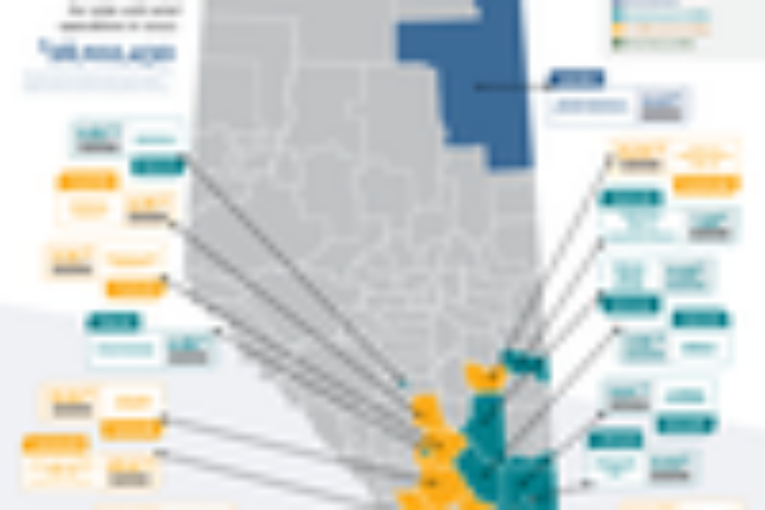
A non-profit organization which is against the province’s renewable energy moratorium has released a new analysis that points out that Alberta municipalities collect millions in taxes from solar and wind projects.
The Business Renewables Centre-Canada (BRC-Canada), an initiative of think tank the Pembina Institute, says in an Oct. 16 release that the amount of municipal tax revenue coming in from renewable energy has almost tripled to $28 million since the amount was first estimated in 2017. BRC-Canada says it calculated the tax revenue each municipality received by using the 2022 tax assessment value of each renewable project and each county’s or municipal district’s tax rate.
The analysis found that some southern Alberta municipalities receive a substantial amount of tax revenues from wind and solar projects. For example, the County of Forty Mile, a rural municipality in southeastern Alberta between Lethbridge and Medicine Hat, collects 50 per cent of its tax revenues from renewable projects, while the municipal districts of Pincher Creek and Willow Creek, based in Claresholm, collect around 30 per cent, according to the analysis.
“What we wanted to do was put a number on (how much revenue municipalities receive) and highlight how much benefit is going to municipalities,” said Jorden Dye, director of the Business Renewables Centre-Canada, during an interview with Postmedia. “Eight of the 18 districts with renewable energy projects are receiving over $1 million.”
Renewable energy projects offer municipalities long-term revenue streams and allow them to plan for the future, he said.
“Whether that’s keeping property taxes for residents low or new investments in the community, we just want to highlight the role renewable energy projects are playing in helping stabilize municipal revenues,” said Dye.
Business Renewables Centre-Canada believes the province’s seven-month moratorium on the approval of new renewable projects over one megawatt — the pause ends on Feb. 29, 2024 — was “short-sighted” and is hurting municipalities.
“One of the things we wanted to highlight is that at a minimum that pause pushes back any projects that weren’t already under construction until at least March of next year,” said Dye, adding that delay in turn affects when municipalities will receive revenue from those projects.
Based on the 2022 calculations and the projects currently in the Alberta Electric System Operator connection queue, the municipalities can expect that amount to grow by an additional $170 million to $250 million in just a few years, he said.
“We’re still at the very beginning of this revenue curve for municipalities. That’s what we’re worried about the moratorium jeopardizing.”
Wind and solar power projects are capital-intensive projects and are “sensitive” to escalating costs, said Dyer.
“By introducing more risk into the market, the government has raised that cost of capital, and that’s where we see one of the major impacts playing out,” he said.
New Pembina Institute released alongside the analysis showed 75 per cent of Albertans, including 66 per cent of Albertans living outside of Edmonton and Calgary, would like to see more renewable energy projects where they live, said Dye.
“That finding really aligns with what we’re seeing, from value to landowners, to value to municipalities,” he said. “We’re an energy province, and the people of Alberta want to see us build more energy projects.”
Vulcan County Reeve Jason Schneider said renewable energy projects currently make up over 40 per cent of the municipality’s assessment base and has played a big role in diversifying the municipality’s tax base.
“We’re trying to do a bit of a hybrid where we’re trying to invest some of the money, lower taxes to make Vulcan County even more attractive to people to live, to work, to run their businesses in,” Schneider said.
The County is home to a 300-megawatt wind project, Blackspring Ridge, and Canada’s largest solar project, the 465-megawatt Travers Solar. Once the 514.6-megawatt Buffalo Plains wind project comes online — construction began earlier year — the municipality will be over 50 per cent. It’s a dramatic shift in revenue streams for Vulcan County, which in the past few years has seen a significant decline in its municipal revenue from oil and gas projects.
Vulcan County is planning long-term so that the municipality remains sustainable when the projects are no longer around, he said.
Renewable energy projects have been greatly benefitted Vulcan County, but the municipality’s council favours the moratorium so that the province has time to look at regulatory changes around project placement and reclamation, and transmission line capacity, said Schneider.
“We’re not saying, ‘Don’t kill it, it’s been very good to Vulcan County, but we just want good developers,” he said.
You can read more of the news on source
